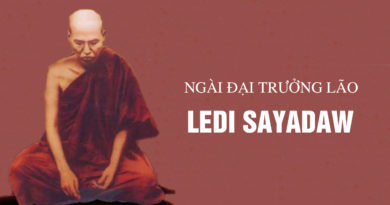VIPASSANA MEDITATION – CHAPTER 3: SEVEN BENEFITS OF MINDFULNESS MEDITATION
MAIN CONTENT
VIPASSANA MEDITATION – CHAPTER 3: SEVEN BENEFITS OF MINDFULNESS MEDITATION
Seven benefits of Mindfulness meditation as taught by the Buddha are recorded in the Maha Satipatthana Sutta – the Discourse on the Four Foundations of Mindfulness. But before I deal with them, I want to explain to you briefly the four aspects of Buddhism. These four aspects are
- Devotional aspect of Buddhism,
- Ethical aspect of Buddhism,
- Moral aspect of Buddhism,
- Practical aspect of Buddhism (including the experiential aspect).
PART 1 – DEVOTIONAL ASPECT
The devotional aspect of Buddhism means rites and rituals, chanting of suttas and parittas, offering of flowers and incense as well as offering of food and robes. When we perform such good deeds, we do so with sraddha (in Sanskrit) or saddha (in Pali).
The word saddha is difficult to translate into English. There is no English equivalent for the Pali word saddha If we translate saddha to be faith, the word faith does not cover the real sense, and if we translate it as confidence, it also does not cover the real sense of saddha. We cannot find a single word in English which can give a complete meaning of saddha To me, saddha can be taken to mean belief through right understanding of the Dhamma.
When we perform religious ceremonies we do it with a belief in the Triple Gem (Tiratana). We believe in the Buddha, the Dhamma (his teachings) and the Sangha (the Order of Buddhist monks). We hold the view that the Buddha has eradicated all defilements through his supreme enlightenment, so he is worthy of respect (an Arahant). He was Buddha because he had strived and was enlightened by himself, not because he learned the Dhamma from any teacher. We believe in the Buddha in this way. The Buddha taught us to live happily and peacefully and he taught us the way leading to the cessation of all kinds of sufferings. We believe that if we follow his teaching or his way, we are sure to live happily and peacefully and to get rid of suffering. For this reason, we believe in the Dhamma. In the same way, we believe in the Sangha. When we say Sangha, it mainly means theAriya sangha, the Noble Sangha who have attained any one of the four stages of the Path (magga). But in the general sense, it also refers to the Sammuti sangha (those who are still striving to eradicate the defilements). Thus we pay homage to the Triple Gem (Tiratana) – the Buddha. Dhamma and Sangha. We also believe that by chanting suttas and parittas as taught by the Buddha, we perform meritorious deeds which will be conducive to the cessation of suffering. Performing these meritorious deeds forms the devotional aspect of Buddhism. However, we should not be content with this devotional aspect if we want to enjoy the essence of Buddhism and be free from all kinds of suffering. Therefore, we must proceed to practise the higher aspects.
Part 2 – Ethical Aspect
The second aspect of Buddhism is the ethical aspect. This is following the Buddhas teaching regarding our actions, speech and mental purification. There are many doctrines concerned with the ethical aspect of Buddhism.
By following these doctrines, we can lead a happy life in this existence as well as the next but we cannot yet be rid of suffering totally. The ethical aspects of Buddhism are:
- Refraining from all kinds of evil deeds,
- Performing meritorious or good deeds,
- Purifying the mind from all kinds of defilements.
These are the three parts of the ethical aspect of what the Omniscient Buddha has taught us and they are the exhortations of all the Buddhas. If we follow these doctrines, we can lead a happy and peaceful life because Buddhism is founded on the Law of Cause and Effect. If we refrain from all kinds of evil deeds, we will not suffer any bad results.
As to the purification of mind from defilements, we have to practise Samatha meditation as well as Vipassana meditation. With Samatha meditation our mind can be purified only while it is engaged in the meditative practice, but when it is not, defilements will attack us again. If we purify our minds through the realization of the mind body processes in their true nature, the defilements will not return. Realization or insight into mental and physical phenomena is known as Vipassana nana (insight knowledge). It overcomes some aspects of defilements and reduces defilements such as greed, anger, delusion and so on. Certain defilements which have been destroyed by means of Vipassana nana (penetrative insight) will not be able to attack us again.
In other words, when we have experienced insight knowledge, that experience will not disappear or go away from us. When we reflect on the experience we have had during meditation, the insight that we attained comes to us again, and with this insight, some aspects of defilements abandoned by insight will not arise again. Thus, we can purify our minds from some defilements. But if we have enough saddha, we will put forth greater effort in our practice and attain the Fourth Path, Arahantship. Then we can exterminate every defilement..
When the defilements have been totally destroyed and the mind completely purified there will not arise any dukkha or suffering. Suffering ceases to exist. This purification of the mind from defilements is concerned with the practical aspect of Buddhism whereas the former two points are concerned with the ethical aspect of Buddhism.
There is also the Mangala Sutta (Sutta nipata, verses 258-269) with 38 kinds of blessings. In the suttas are many ethics to follow which enable us to live happily and peacefully such as:
- You should live in a suitable place where you can be prosperous in every aspect, having done meritorious deeds in the past.
- You should do meritorious deeds as much as possible at present too.
- You must watch your deeds, speech and mind properly.
That means, we should keep our deeds, speech and thoughts free from defilements. In this way, we have many aspects of ethics to follow so that we can live happily and peacefully.
I want to remind you of the Ambalatthika Rahulovadasutta (Majjhima nikaya, Sutta No.61) which may be familiar to you. In that sutta, the Buddha encouraged his son, Rahula, who was a seven year old samanera, to live properly, happily and peacefully. The Buddha taught Rahula to stop and reflect whenever he had the intention of doing something.
Rahula, you must be mindful of what you are going to do and consider whether this deed will be harmful to yourself or to others. By considering thus, if you find that this deed will be harmful to yourself or to others, you must not do it. But if this deed will not be harmful to yourself or to others, you may do it.
In this way, the Buddha instructed Rahula to consider what is to be done, to be aware of what is being done and to reflect on what has been done. So this ethic too is the best way for living happily and peacefully in our daily life. There are innumerable aspects of ethics conducive to a happy and peaceful life. If we try to understand these ethics and follow them, we are sure to live a happy and peaceful life although we cannot yet get rid of all our suffering.
Part 3 – Moral Aspect
Though these ethics are very conducive to a happy and peaceful life, we should not be contented merely with the second aspect of Buddhism. We should proceed to the higher aspects of Buddhism, the third aspect- the moral aspect. In the moral aspect, you must observe precepts, either five, eight or ten. The ten precepts are for novices (samaneras) while the 227 rules are for monks (bhikkhus). In daily life, we must observe at least the five precepts. When we can observe the five precepts perfectly, our morality is purified. When moral conduct is purified, a meditator can easily practise meditation, either Samatha or Vipassana meditation. Based on purification of moral conduct, a meditator can easily concentrate on the object of meditation and gain deep concentration, whereby the mind is clear, serene and happy.
Part 4 – Practical Aspect
Next, we have the fourth aspect, i.e. the practical aspect of Buddhism. We must practise meditation so that we can deliver ourselves from defilements and, as a result, attain the cessation of all kinds of suffering. Here, we practise two kinds of meditation which make up the practical aspect of Buddhism – one to enable us to attain deep concentration, and the other to enable us to attain the cessation of suffering through the realization of mentality and physicality in their true nature. The Buddha stressed the second type of meditation – Vipassana meditation. When we practise Vipassana meditation, we have to follow the Maha Satipatthana Sutta, the discourse on the Four Foundations of Mindfulness. If we apply mindfulness to all our mind body processes, we are sure to attain the cessation of suffering. The Buddha described the four Foundations of Mindfulness when he gave the discourse on Maha Satipatthana Sutta in Kuru province.
Part 5 – Seven Benefits Of Meditation
In the introductory passage of that sutta, the Buddha explained the seven benefits which a meditator can gain through his own experience of Dhamma.
The First Benefits purification. When a person practises mindfulness, he can purify his being from all defilements. The Pali word kilesa may be familiar to you. The word kilesa is translated as defilements by Buddhist scholars. The kilesa are of ten main kinds:
- Lobha
- Dosa
- Moha
- Ditthi
- Mana
- Vicikiccha
- Thina middha
- Uddhacca kukkucca
- Ahirika
- Anottappa
- Lobha means not only greed but also desire, lust, craving, attachment and love. When one of these mental states arises in us, our mind gets defiled. So these are known as defilements.
- Dosa is hatred, anger, ill will or aversion.
- Moha is delusion or ignorance.
- Ditthi is wrong view or false view.
- Mana is conceit.
- Vicikiccha is sceptical doubt.
- Thina middha is sloth and torpor. Sleepiness also comes under sloth and torpor. Sloth and torpor are old friends of meditators and also those who listen to the Dhamma.
Today, during interview, all the meditators reported the experience: I am tired, 1 feel sleepy. At the beginning of the practice, we have to struggle because we have not yet become accustomed to the task of mindfulness meditation. This is a critical stage of meditation, but it will not last long. It may last for two or three days. After three days, all meditators will be all right. They will not find it too difficult to overcome these old friends which are obstructing their progress in concentration as well as insight.
- Uddhaaca kukkucca means restlessness and remorse.
- Ahirika means moral shamelessness. One who is not ashamed of evil deeds in speech, thought and action.
- Anottappa means moral fearlessness – that is one is not afraid of evil deeds in speech, thought and action. This moral fearlessness is one of the defilements.
These are the ten kinds of defilements which must be abandoned or removed from our minds by means of Vipassana meditation. The Buddha says: If one practises mindfulness meditation, one can be purified from all defilements.
That means, he can attain Arahantship when he is completely purified from all kinds of defilements. This is the first benefit.
The Second Benefit of mindfulness is the overcoming of sorrow and worry.
You will not be worried about failure, or be sorry about the death of your relatives, or about the loss of your work. You will not be sorry about anything if you practise this mindfulness meditation. Although you have not attained any Path and Fruition (magga and phala ), you can overcome sorrow and worry to some extent, because when sorrow or worry arises, you will be mindful of it as it is. When mindfulness becomes powerful, that worry or sorrow will stop and disappear. When you have completely developed mindfulness meditation, you are sure to attain Arahantship, and hence be free from worry and sorrow permanently. In this way, worry and sorrow can be overcome by mindfulness meditation.
The Third Benefit is that of overcoming lamentation. Although your parents, children or relatives die, you will not have any lamentation for them because you have fully realized that mental and physical processes constitute the so called child or the so called parents. In this way, lamentation can be overcome by mindfulness meditation. Regarding the third benefit, the commentary on the Maha Satipatthana Sutta mentions a story: A woman, named Patacara, whose husband, two sons, parents and brothers had died within a day or two, went mad due to sorrow, worry and lamentation. She was overwhelmed by sorrow over the death of the people she loved.
The commentary mentions this story as proof that one can overcome sorrow, worry and lamentation by means of mindfulness meditation.
One day, the Buddha was giving a discourse to an audience at Jetavana monastery near Savatthi. Then this mad woman, who was going for a stroll, went into the monastery and saw the audience listening to the discourse. She approached the audience. An old man, who was very kind to the poor, took off his upper robe threw it to the woman and said to her. “Dear daughter, please use my robe to cover your body.” At the same time the Buddha said to her, “Dear sister, be mindful.” Because of the soothing voice of the Buddha, the mad woman come to her senses. She then sat at the edge of the audience and listened to the discourse. The Buddha, knowing that she had come to her senses, aimed his discourse at her. Listening to the discourse given by the Buddha, the womans mind gradually absorbed the essence of the doctrine. When her mind was well prepared to realise the Dhamma, the Buddha expounded the Four Noble Truths:-
- Dukkha sacca (The Truth of Suffering)
- Samudaya sacca (The Truth of the Cause of Suffering)
- Nirodha sacca (The Truth of the Cessation of Suffering)
- Magga sacca (The Truth of the Way Leading to the Cessation of Suffering)
The Fourth Noble Truth includes advice on how to be mindful of whatever arises in our mind and body as it really is.
Patacara, having come to her senses, rightly understood the technique of mindfulness, applied it to whatever arose in the mind body processes and to whatever she heard. As her mindfulness gained momentum, her concentration became deeper and stronger. Because her concentration became deep, her insight and penetrating knowledge of the mind – body processes became powerful, and she gradually realized both the specific characteristics and common characteristics of mental and physical phenomena. Thus she progressively experienced all the stages of insight knowledge while listening to the discourse, and attained the First Path, Sotapatti magga. Through her own personal experience of the Dhamma by means of mindfulness meditation, the sorrow, worries and lamentation she had had, totally disappeared from her mind, and she became a new woman. Thus she overcome her worry, sorrow and lamentation by means of mindfulness meditation. So the commentary on the Maha Satipatthana Sutta mentioned not only the people during the time of the Buddha, but also people nowadays can overcome sorrow and worry if they practise this mindfulness meditation to attain some higher stages of insight. You are also included in those people who can overcome sorrow and worry by means of mindfulness meditation.
The Fourth Benefit is the cessation of physical suffering.
The Fifth Benefit is the cessation of mental suffering.
Physical suffering such as pain, stiffness, itchiness, numbness and so on can be overcome by this mindfulness in meditation retreats as well as in daily life. When you have some experience in the meditation practice, you can overcome your mental and physical suffering to a large extent. If you invest enough effort and time you can exterminate both mental and physical suffering permanently when you have attained Arahantship. But during meditation, you can overcome pain, stiffness, numbness, itchiness and all kinds of unpleasant physical sensations by observing them very attentively and closely. Therefore, you need not be afraid of pain, stiffness or numbness because these are your good friends who can help you to attain the cessation of suffering. If you observe the pain energetically, precisely and closely, it may seem more severe because you know it more and more clearly. When you have comprehended the unpleasantness of this painful sensation, you will not identify it with yourself because the sensation is perceived as just a natural process of mental phenomena. You are not attached to the painful sensation as I or mine or me, or a person or a being. In this way, you can eradicate the wrong view of a soul, a self, a person, a being, an I or a you.
When the root of all kinds of defilements, i.e. sakkaya ditthi or atta ditthi has been destroyed you are sure to attain the First Path, Sotapatti magga. Then you can proceed with your practice to attain the three higher stages of the Path and Fruition. That is why I say that unpleasant physical sensations such as pain, stiffness and numbness are your good friends who can help you to attain the cessation of suffering. In other words, this numbness or any painful sensation is the key to the door of nibbana. When you feel pain, you are lucky. Pain is the most valuable object of meditation because it attracts the noting mind to stay with it for a very long time. The noting mind can concentrate on it deeply and be absorbed in it. When the mind is completely absorbed in the painful sensation, you will no longer be aware of your bodily form or yourself. It means you are realizing the sabhava lakkhana of the pain or the individual characteristic of the painful sensation (dukkha vedana). Proceeding with the practice you will be able to realise the common characteristics of impermanence, suffering and no soul or no self nature of mental and physical phenomena. Then that will lead you to the cessation of all kinds of sufferings. So you are lucky if you have pain.
In Burma, some meditators, having passed the third stage of insight knowledge (sammasana nana), almost completely overcame all painful sensations, but were dissatisfied with their practice because they had no pain to note. So they folded their legs under themselves and pressed them so that they could get pain. They were looking for their good friend who could lead them to the cessation of suffering.
When you feel unhappy, please observe that unhappiness insistently, attentively and very closely as unhappy, unhappy. If you feel depressed, that depression must be observed very attentively and perseveringly. When your mindfulness becomes powerful, the unhappiness and depression will cease to exist. So the overcoming of mental suffering is the fifth benefit of mindfulness meditation
The Sixth Benefit is the attainment of enlightenment, the Path and Fruition (magga and phala). When you devote enough time and effort to your mindfulness meditation, you will attain at least the First Path, Sotapatti magga. This is the sixth benefit of mindfulness meditation.
The Seventh Benefit is that you are sure to attain nibbana, deliverance, emancipation through mindfulness meditation.
The seven kinds of benefits of mindfulness meditation which the Vipassana meditator can gain through personal experience of Dhamma:
- Purification from all kinds of defilements.
- Overcoming sorrow and worry.
- Overcoming lamentation.
- Cessation of all kinds of physical suffering.
- Cessation of all kinds of mental suffering.
- Attainment of enlightenment.
- Attainment ofnibbana.
The Buddha began the Maha Satipatthana Sutta with these seven benefits of mindfulness meditation. So you are sure to acquire these seven benefits if you put strenuous effort into your practice.
We are lucky because we believe in the Buddha who is enlightened and who teaches the right way which leads to the cessation of suffering. But we should not be complacent. In the Pali texts, there is a simile:
There is a great pond full of clear water with many lotus flowers in it. A travellers hands are dirty. He knows that if he washes them in the pond, they will be clean. But though he knows it, he does not go to the pond to wash his hands, his hands are still dirty. In this way, he passes the pond and continues his journey.
Then the question was asked in the text: “If the man remains dirty, who is to be blamed, the pond or the traveller?” Obviously, the traveller. Though he knew he could wash the dirt away in the pond, he did not do it. Therefore, the traveller is to be blamed. The Buddha teaches us the way of mindfulness. If we know the way but do not practise this mindfulness meditation, we will not get rid of suffering. If we do not get rid of suffering, who should be blamed? The Buddha, the way of mindfulness, or us? Yes, we should be blamed. If you practise this mindfulness meditation with strenuous effort, you will purify yourself from all defilements and get rid of suffering by obtaining these seven kinds of benefit., of mindfulness meditation.









